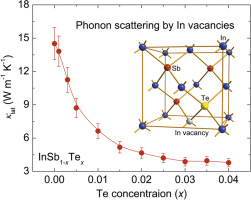Nano Energy ( IF 17.6 ) Pub Date : 2018-03-22 , DOI: 10.1016/j.nanoen.2018.03.058 Jun Mao , Jennifer L. Niedziela , Yumei Wang , Yi Xia , Binghui Ge , Zihang Liu , Jiawei Zhou , Zhensong Ren , Weishu Liu , Maria K.Y. Chan , Gang Chen , Olivier Delaire , Qian Zhang , Zhifeng Ren

|
Phonon scattering by point defects via mass differences and strain fluctuations could effectively reduce the lattice thermal conductivity. The atomic mass difference can be maximized by introducing the vacancies thus leading to a significant phonon scattering. Usually, the vacancies are introduced by tuning the stoichiometry or forming solid solution with certain compound that contains intrinsically high concentration of vacancies. In this work, we demonstrate that vacancies can be effectively induced by the self-compensation effect via chemical doping. Indium (In) vacancies in InSb were induced by Te-doping and a substantial reduction in thermal conductivity was observed. Room temperature lattice thermal conductivity of the melted and then hot-pressed InSb (without In vacancies) is ~ 14.5 W m−1 K−1 but only ~ 3.8 W m−1 K−1 for InSb0.96Te0.04 (with In vacancies), a reduction of ~ 74%. The advantage of using this strategy for phonon engineering lies in the fact that a substantial reduction in thermal conductivity can be achieved even when the dopant concentration is rather low. Since the self-compensation effect is widely observed in different compounds, it indicates that the vacancy engineering strategy used here is also applicable to a variety of other materials to effectively reduce the lattice thermal conductivity.
中文翻译:

自补偿诱导的空位使InSb中的明显声子散射
通过质量差和应变波动使点缺陷引起的声子散射可有效降低晶格导热系数。通过引入空位可以使原子质量差最大化,从而导致明显的声子散射。通常,通过调节化学计量或与含有本质上高浓度的空位的某些化合物形成固溶体来引入空位。在这项工作中,我们证明了空缺,可以有效地自我补偿效应引起的经化学掺杂。通过Te掺杂可以诱导InSb中的铟(In)空位,并且可以观察到热导率大大降低。熔化后再热压的InSb(无In空位)的室温晶格热导率为〜14.5 W m -1 K -1,但对于InSb 0.96 Te 0.04仅为〜3.8 W m -1 K -1(空缺职位),减少了约74%。使用这种策略进行声子工程的优势在于,即使掺杂剂浓度相当低,也可以实现导热系数的大幅降低。由于在不同的化合物中广泛观察到自补偿效应,因此表明此处使用的空位工程策略也适用于多种其他材料,以有效降低晶格导热系数。



























 京公网安备 11010802027423号
京公网安备 11010802027423号